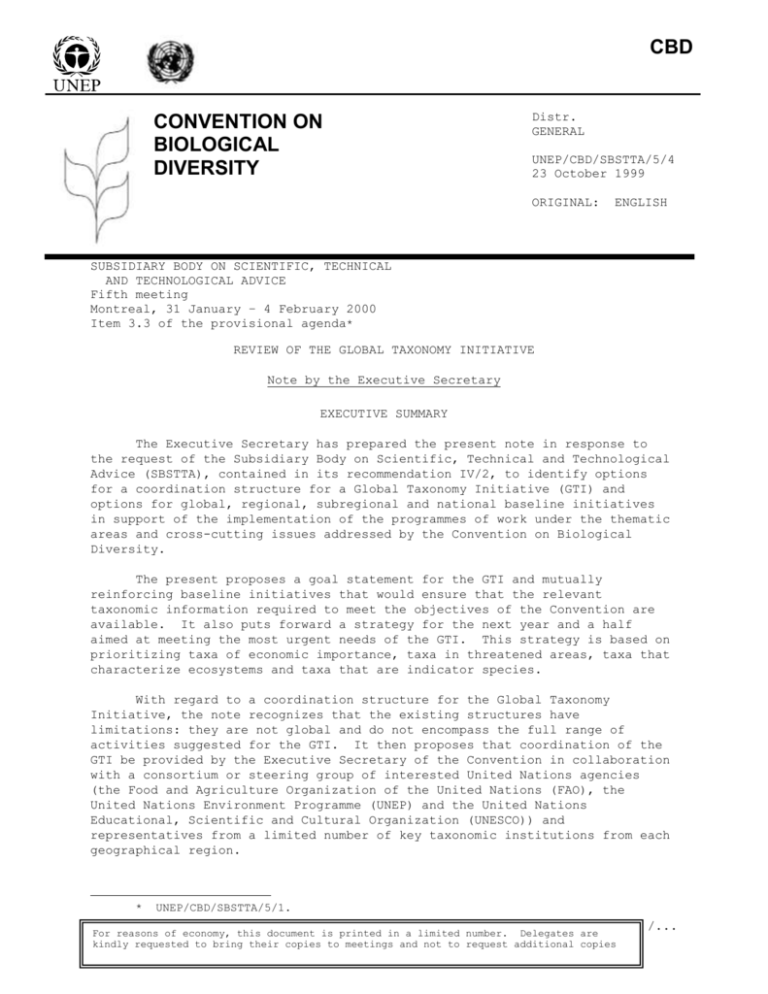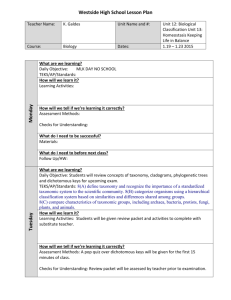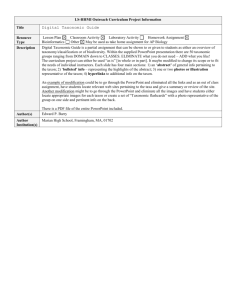B. Proposed elements of the baseline taxonomy initiatives
advertisement

CBD CONVENTION ON BIOLOGICAL DIVERSITY Distr. GENERAL UNEP/CBD/SBSTTA/5/4 23 October 1999 ORIGINAL: ENGLISH SUBSIDIARY BODY ON SCIENTIFIC, TECHNICAL AND TECHNOLOGICAL ADVICE Fifth meeting Montreal, 31 January – 4 February 2000 Item 3.3 of the provisional agenda* REVIEW OF THE GLOBAL TAXONOMY INITIATIVE Note by the Executive Secretary EXECUTIVE SUMMARY The Executive Secretary has prepared the present note in response to the request of the Subsidiary Body on Scientific, Technical and Technological Advice (SBSTTA), contained in its recommendation IV/2, to identify options for a coordination structure for a Global Taxonomy Initiative (GTI) and options for global, regional, subregional and national baseline initiatives in support of the implementation of the programmes of work under the thematic areas and cross-cutting issues addressed by the Convention on Biological Diversity. The present proposes a goal statement for the GTI and mutually reinforcing baseline initiatives that would ensure that the relevant taxonomic information required to meet the objectives of the Convention are available. It also puts forward a strategy for the next year and a half aimed at meeting the most urgent needs of the GTI. This strategy is based on prioritizing taxa of economic importance, taxa in threatened areas, taxa that characterize ecosystems and taxa that are indicator species. With regard to a coordination structure for the Global Taxonomy Initiative, the note recognizes that the existing structures have limitations: they are not global and do not encompass the full range of activities suggested for the GTI. It then proposes that coordination of the GTI be provided by the Executive Secretary of the Convention in collaboration with a consortium or steering group of interested United Nations agencies (the Food and Agriculture Organization of the United Nations (FAO), the United Nations Environment Programme (UNEP) and the United Nations Educational, Scientific and Cultural Organization (UNESCO)) and representatives from a limited number of key taxonomic institutions from each geographical region. * UNEP/CBD/SBSTTA/5/1. For reasons of economy, this document is printed in a limited number. Delegates are kindly requested to bring their copies to meetings and not to request additional copies /... UNEP/CBD/SBSTTA/5/4 Page 2 SUGGESTED RECOMMENDATIONS In order to consolidate the programme of work on the Global Taxonomy Initiative (GTI) and provide the impetus to address the taxonomic impediment to conservation and management of the world’s biodiversity identified in decisions II/2, III/10 and IV/1 D, the Subsidiary Body on Scientific, Technical and Technological Advice may wish to recommend that the Conference of the Parties: 1. Endorses a coordination structure for the Global Taxonomy Initiative consisting of the Executive Secretary of the Convention on Biological Diversity, a consortium or steering group of interested United Nations agencies (the Food and Agriculture Organization of the United Nations (FAO), the United Nations Environment Programme (UNEP) and the United Nations Educational, Scientific and Cultural Organization (UNESCO)) and representatives from key taxonomic institutions (one from each geographical region); 2. Endorses the following baseline taxonomy initiatives: (a) Identification of priority information requirements; (b) Undertaking assessments of national taxonomic capacity; (c) Using the Global Taxonomy Initiative as a communication tool; and (d) Integration into thematic and cross-cutting work programmes; 3. Requests the coordination structure for the Global Taxonomy Initiative: (a) To draft a strategic plan, for consideration by the Subsidiary Body on Scientific, Technical and Technological Advice; and (b) Initiate short-term activities to start meeting the most urgent global taxonomic needs with clearly set objectives, and report thereon at the sixth meeting of the Conference of the Parties. /... UNEP/CBD/SBSTTA/5/4 Page 3 CONTENTS Paragraphs Pages EXECUTIVE SUMMARY..................................................... 1 SUGGESTED RECOMMENDATIONS............................................. 2 I. II. INTRODUCTION............................................ 1-4 4 PROPOSED BASELINE TAXONOMY INITIATIVES IN SUPPORT OF PROGRAMMES OF WORK UNDER THE CONVENTION ON BIOLOGICAL DIVERSITY ON THEMATIC AREAS AND OTHER CROSS-CUTTING ISSUES.................... 5-30 5 A. B. C. Overall objectives, approach and guiding principles ......................................... 5-9 5 Proposed elements of the baseline taxonomy initiatives ........................................ 10-23 6 Identification of a coordination structure for the Global Taxonomy Initiative ................. 24-30 9 /... UNEP/CBD/SBSTTA/5/4 Page 4 I. INTRODUCTION 1. The Global Taxonomy Initiative (GTI) is a response to a recognized taxonomic impediment to conservation and management of the world’s biodiversity and has been endorsed and amplified by several decisions of the Conference of the Parties (decisions II/2, III/10 and IV/1 D). 2. At its fourth meeting, the Subsidiary Body on Scientific, Technical and Technological Advice was requested to give advice on the Initiative in the form of a set of operational guidelines and parameters that could amplify how the Convention requires a GTI to work. In a note prepared by the Executive Secretary (UNEP/CBD/SBSTTA/4/6) an indicative list of some of the key products, tools or instruments for taxonomy-related capacity-building was given. 3. In its recommendation IV/2, SBSTTA recognized that development and implementation of a GTI will occur through activities that amplify and operationalize the suggestions for action contained in the annex to decision IV/1 D at the national, subregional, regional and global levels. It consequently requested the Executive Secretary to identify options for a coordination structure for a GTI and options for global, regional, subregional and national baseline initiatives in support of the implementation of established programmes of work of the Convention on Biological Diversity, and to report thereon to SBSTTA at its fifth meeting. 4. The present note has been prepared by the Executive Secretary in response to that request, bearing in mind the request by the Conference of the Parties, in its decision IV/1 D, for advice and recommendations for consolidation of the programme of work on the GTI, and the other recommendations formulated by SBSTTA at its fourth meeting. The note draws on the main findings of several key meetings of experts 1/ held to identify proposed elements for the further development of the programme of work on the GTI. 1/ The meetings include inter alia: (a) The Crete workshop convened by DIVERSITAS in 1997; (b) The Darwin Workshop on "Removing the Taxonomic Impediment", co-convened by Environment Australia and the National Museum of Natural History, Smithsonian Institution, in 1998 (report accessible at http://www.anbg.gov.au/abrs/flora/webpubl/darwinw.htm); (c) A meeting on "The Global Taxonomy Initiative: Shortening the Distance between Discovery and Delivery", held in London in 1998, at the Linnean Society, under the auspices of DIVERSITAS, the Scientific and Technical Advisory Panel of the Global Environment Facility (GEF) and Environment Australia (report available at http://www.anbg.gov.au/abrs/flora/webpubl/london.htm). (d) The New York workshop on "Using Systematic Inventories to Meet Country and Regional Needs" held in 1998 (UNEP/CBD/SBSTTA/4/Inf.7); and (e) A workshop held in Paris in 1999 to give an overview of the state of our knowledge of species-level diversity. /... UNEP/CBD/SBSTTA/5/4 Page 5 II. PROPOSED BASELINE TAXONOMY INITIATIVES IN SUPPORT OF PROGRAMMES OF WORK UNDER THE CONVENTION ON BIOLOGICAL DIVERSITY ON THEMATIC AREAS AND OTHER CROSS-CUTTING ISSUES A. Overall objectives, approach and guiding principles 5. The overall aim of the baseline taxonomy initiatives is to ensure that the relevant taxonomic information required to meet the objectives of the Convention is available, in line with relevant decisions of the Conference of Parties, notably decisions III/10 on, identification, monitoring and assessment, and IV/1 D, on the Global Taxonomy Initiative. The specific objectives are spelt out in the annex to decision IV/1 D. 6. Implementation of the Convention on Biological Diversity requires activity in three key areas: identification, assessment and monitoring; conservation; and sustainable use. Each requires the support of a number of taxonomic activities, such as biological survey, collecting and taxonomy, rapid assessment methods (indicator groups, higher taxa, morphospecies), biodiversity inventories, possibly some including all taxa within an area, molecular assessment methods for micro-organisms, assessment of phylogenetic diversity, identification of taxa requiring conservation action, taxonomic understanding of species on red lists, indicator species taxonomy, reserve site selection criteria based on taxon richness, endemism, and representativeness, wild relatives of domesticated species, identification of resources for harvesting, bioprospecting, etc., integration of ethnobiological knowledge, development of predictive phylogenetic tools, taxonomy of keystone species for ecosystem services, indicators of sustainable use, identifying agents for use in biological control, invasive species management and disease control, and information to underpin ecotourism. 7. The proposed elements of the baseline initiatives proposed below have been developed bearing in mind the following needs: (a) To support the development of national biodiversity strategies, action plans, programmes and reports, in line with Articles 6, 26 and 23, paragraph 4 (a) of the Convention and decisions II/17, on forms and intervals of national reports by Parties, IV/14, on national reports by Parties and IV/1 D, on the Global Taxonomy Initiative; (b) To build upon existing activities and plans of action and other agreements that have been adopted by Parties and international agencies, such as the DIVERSITAS systematics element, BioNET International, Global Biodiversity Information Facility of the Organisation for Economic Cooperation and Development (OECD), Species Plantarum (The International Organisation for Plant Information/International Union of Biological Sciences), Man and the Biosphere Flora and Fauna (UNESCO), International Network for DIVERSITAS in Western Pacific and Asia, the Major Systematic Entomology Facility, European Science Foundation Network on Systematic Biology, Ocean Biogeographic Information System, Integrated Taxonomic Information System, CONABIO, Southern African Botanical Diversity Network (SABONET); (c) To provide useful products to other relevant programmes of work under the Convention, including those relating to agricultural biodiversity, forest biological diversity, mountains, inland water biological diversity, marine and coastal biological diversity, and drylands, as well as crosscutting issues such as the ecosystem approach, access and benefit-sharing, /... UNEP/CBD/SBSTTA/5/4 Page 6 sustainable use, indicators, alien species, and issues related to Article 8(j); (d) To promote synergy and coordination, and to avoid duplication, between relevant programmes of various international organizations and between programmes at the national and regional levels established under the auspices of international organizations, while respecting the mandates and existing programmes of work of each organization and the intergovernmental authority of the respective governing bodies, commissions and other forums. 8. In implementing the baseline taxonomy initiatives, the special role that the GTI has in providing knowledge fundamental to the ecosystem approach adopted under the Convention (UNEP/CBD/SBSTTA/5/11) should be emphasized, and a multidisciplinary approach that takes into account scientific, social and economic issues is required. 9. All projects should focus on both short-term and long-term products, which will emanate from the regional workshops and should lead to actions that directly relate to the regional/national obligations of Parties under the Convention on Biological Diversity. Importantly, short-term outputs need to be available in 12-18 months to both demonstrate the success of the project and to feed into regional/national reporting. B. Proposed elements of the baseline taxonomy initiatives 10. Based on the above, the following elements are proposed as options to be considered by SBSTTA for global, regional, subregional and national baseline initiatives in support of the implementation of the programmes of work under the Convention on Biological Diversity on thematic areas and cross-cutting issues. It is important to note that the four elements proposed below are intended to be mutually reinforcing, i.e. outputs of certain elements would feed into others. Accordingly, the ordering of the elements does not imply sequential implementation. However, prioritization of activities within each element will be necessary. Element 1. Identification of priority information requirements 11. The needs for conservation and sustainable use of biodiversity and its components should drive the identification of priority information requirements. Fulfilling these needs should be done using the best data and current analyses that can be provided by the scientific community. The GTI should also be driven by the needs of the Parties in implementing the ecosystem approach, and the two issues (i.e., GTI and the ecosystem approach) developed conjointly. 12. A suggested first step in identifying the priority information requirements is to use a case-study approach. Case-studies could be undertaken in a limited number of regions, preferably not more than five representative regions for each thematic area addressed by the Convention, taking into account the cross-cutting issues (e.g., alien species, access to genetic resources and benefit-sharing). 13. Identification of priority information needs requires active cooperation between the taxonomic, ecological and natural resource management communities. The existing organizational structure should be involved in this process, while also encouraging the development of novel fully /... UNEP/CBD/SBSTTA/5/4 Page 7 operational models tailored to the obligations of Parties under the Convention on Biological Diversity. 14. The Convention Secretariat (through the GTI Programme Officer) will develop a comprehensive work plan, including outlining the major issues by region in consultation with the afore-mentioned communities. This outline will be the starting point for meeting discussions. The Secretariat will also coordinate the organization of the regional meetings focused on thematic areas to define key taxonomic and ecological priorities. The GTI coordination structure (described in paragraphs 24-30 below) will facilitate these regional meetings to progress project development and implementation, through providing regional support to help select institutions, and assist with logistics and follow-through. Regional institutions, working with key institutions in the developed world (which have traditional or current interests/collections/data) should be charged with developing the plan. Inherent in any meeting should be data exchange, training and other capacity building activities. 15. Results from regional meetings should also help develop financial priorities for the implementation of the GTI, including its integration into the operational programmes of the Global Environment Facility. An agreed overall approach among both the scientific and the policy community is the first step to achieving the aims of the GTI. The GTI will need to be financed with various levels of governmental and non-governmental involvement, not only by multilateral institutions but also from other sources. Element 2. Undertaking assessments of national taxonomic capacity 16. The critical role that inventories, and the taxonomy that derives from them, play in building national, regional, and global taxonomic capacity cannot be underestimated. Yet, nations vary greatly in their taxonomic infrastructure and human resources to support inventories and associated scientific activities, their preparedness to undertake inventories, and their capacity to develop and implement strategies and action plans to participate in the GTI. 17. There exists a critical need to provide scientific and technical advice to governments and the Convention on Biological Diversity on undertaking assessments of taxonomic capacity, preparing, designing and implementing national strategies to support the GTI, and creating regional networks in support of the GTI. To this end, and building on the recommendations provided in, inter alia, the Darwin Declaration, it is suggested that: (a) Parties to the Convention on Biological Diversity undertake an assessment of national taxonomic capacity as part of the national reporting process, following agreed guidelines that could be prepared in the first instance by the Secretariat of the Convention (via the GTI Programme Officer) in collaboration with relevant organizations, and worked through the GTI coordination structure (see paragraphs 24-30 below); (b) The Secretariat of the Convention on Biological Diversity in conjunction with the Parties to the Convention, develop a taxonomic strategy and action plan to strengthen national capacity to participate in the GTI, for example, by developing guidelines; (c) Through regional workshops, within the context of national needs and capabilities, efforts be made to ensure that regional and national action /... UNEP/CBD/SBSTTA/5/4 Page 8 plans help create, enhance, and sustain new or pre-existing regional taxonomic networks that promote the GTI. Element 3. Using the GTI as a communication tool 18. The crucial importance of taxonomy to the conservation and sustainable use of biological diversity is evident both to taxonomists and to those involved in detail with such conservation and use. However, this fundamental point has not been adequately communicated to those who constitute or create markets for the goods and services that taxonomy provides or underpins. These include international donor agencies, national and local governmental bodies, non-governmental organizations, the private sector (e.g., developers, extractive industries, ecotourism, and the media) and educational institutions at all levels. For the work of taxonomy to grow and fulfil its potential, those who do appreciate the value of taxonomy, in particular natural history institutions throughout the world, should orient themselves to these markets, delivering the goods and services that the markets demand and collaborating with those in the marketplace to develop improved products and services. The predominant perception held by non-taxonomists of the taxonomic community is that its vision has been historically inward. This perception must be changed to reflect the modern views and thoughts of the global taxonomic community. 19. The following main areas of activity are suggested: (a) Priorities. The taxonomic community should identify clearly its own priorities in the strengthening of taxonomic capabilities, noting that efforts are already under way through the DIVERSITAS systematics element); (b) Policy and programme development. Taxonomy should be integrated at all levels of government into policies and programmes for sustainable development and biodiversity conservation. These include agriculture, forestry, fisheries, protection of threatened species, biological resources for medicine and human health, energy production, land-use planning to accommodate human population growth, use of traditional knowledge, environmental education and training, print and electronic media, ecotourism and bioprospecting, as well as national and local programmes for inventory and monitoring of biological resources in ecosystems; (c) Development or strengthening of regional initiatives, such as the Southern African Botanical Network (SABONET), to build the GTI with support provided through the financial mechanism; (d) Development of specific training initiatives, following, for example, the European Union's "large-scale facilities model", which utilizes a "mentor" approach. Of critical importance is career development through fellowships (like those offered by North Atlantic Treaty Organization (NATO), the Wellcome Foundation, and others) that provide a commitment to engage the trainee as a permanent employee. GEF should be requested to consider providing assistance to training of this type through a skilfully constructed project framework, with an emphasis on training opportunities that lead to permanent career possibilities, and the continued expansion of taxonomic efforts; (e) Construction of a programme of wider public information on the importance of taxonomic activity. This could form part of the broader initiative on education and public awareness being implemented under decision IV/1 D. Such a programme should particularly target national /... UNEP/CBD/SBSTTA/5/4 Page 9 decision makers in relation to activities under the Convention on Biological Diversity in all countries; (f) Use of a project-based approach with emphasis on partnerships wherever possible. The major aim must be to produce tangible results from larger projects in the shortest possible time-frame. Existing protocols for taxonomic work should be made more widely available and take a global approach. 20. A key success criterion will be an increase in the level of taxonomic information available in useful formats. The increase in available taxonomic knowledge should be measured against a 1999 baseline. Element 4. Integration into thematic and cross-cutting work programmes 21. The main goal of element 4 is to support the development of linkages between the GTI and other thematic and cross-cutting work programmes addressed by Convention on Biological Diversity and to promote their integration. The importance of sound taxonomy to the development of these activities, as well as to general inventory, monitoring and reporting under the Convention is axiomatic. As these activities evolve, they will feedback and help set taxonomic priorities for the GTI. It will be vital to coordinate with the OECD Global Biodiversity Information Facility (GBIF), as this Facility evolves. 22. In developing the GTI, the importance of the clearing-house mechanism for sharing information cannot be overstressed. The clearing-house mechanism needs to develop specific taxonomic modules, which will link with national, regional and global information systems. To achieve this, a project-based approach should be used and partnerships emphasized wherever possible. 23. GEF, based on advice from the Convention on Biological Diversity (see decision IV/1 D, paragraph 9 and annex) should be requested to include in its Operational Programmes clear and specific guidelines/criteria for integrating prioritising taxonomic activities within existing and new GEF projects. In this way maximum effort will be achieved in providing the information base required for the Convention on Biological Diversity, while not impeding the effectiveness of GEF. C. Identification of a coordination structure for the Global Taxonomy Initiative 24. Various meetings held since late October 1997 (see footnote 1 on page 4 above) have produced a number of scenarios for coordination structures for the GTI. 25. All of these existing structures suffer from some limitations, and none is global and encompassing the full range of activities suggested for the GTI in the annex to decision IV/1 D. 26. One model for effective coordination would be for the Executive Secretary, through the GTI Programme Officer, to develop a comprehensive work plan for the GTI. Coordination of the GTI should then be provided through a consortium or steering group consisting of the Executive Secretary and interested United Nations agencies (FAO, UNEP and UNESCO), supplemented by representatives from a small number (five at the most) of key taxonomic institutions, one from each geographic region. /... UNEP/CBD/SBSTTA/5/4 Page 10 27. To help the implementation process, there is a need to establish a formal goal statement for the GTI and select a set of focused activities over the next 12-18 months. This will assist funding agencies to assess and meet the most urgent GTI priorities. 28. A suggested goal is to provide data critical for management driven strategies to promote the objectives of the GTI in key thematic areas. 29. Priority-setting should be carried out by the coordinating body, in collaboration with appropriate organisations and existing networks. Choosing four or five regions in each thematic area, and within each area prioritizing taxa of economic importance, taxa that characterize ecosystems, taxa in threatened areas, and taxa that are indicator species, would be one possible strategy. 30. Another component will be the organization of regional workshops of scientists and policy makers in the key thematic areas. In all this activity, short-term and long-term outputs must be quite clear and include, in particular: (a) An increase in taxonomic information in shared formats; (b) The development of bioregional action plans; (c) The establishment of plans to help create, enhance and sustain new or existing regional taxonomic networks that promote the GTI; (d) The compilation of best practices; (e) Enhanced local and regional capacity in taxonomy; and (f) process. The integration of taxonomic capacity into the national reporting -----








